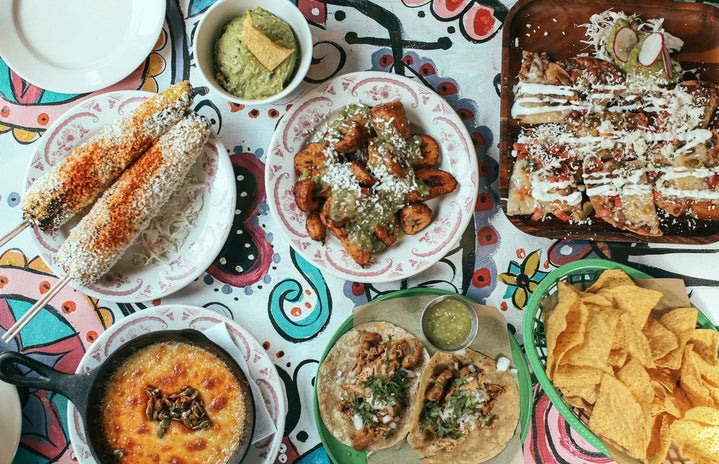Thanksgiving, a uniquely American colonial holiday, is known as the time to eat a traditional feast featuring turkey, stuffing, and mashed potatoes. But families with different cultural backgrounds do it a little differently, by eating “non-traditional” foods. Ethnic and immigrant families use food to transform the day into an improved multicultural Thanksgiving.
Given the widespread belief that Thanksgiving food is overrated, and with Thanksgiving’s gruesome history rooted in conquest and genocide, maybe it’s time to let go of some of the typical traditions. However, it’s an excuse to take time off and have days filled with love, gratitude, and hopefully good food. And since not everyone has the same nostalgia associated with a traditional American Thanksgiving feast, I asked 10 college students with multicultural backgrounds what their families actually eat for Thanksgiving. Here’s what they had to say.
“My dad is white, so we have [typical] Thanksgiving food. HOWEVER, my mom is Filipino, so we also have some traditional Pinoy food on Thanksgiving. My mom makes pancit, which is a delicious noodle dish with cabbage, shrimp and pork. She also makes adobo — a savory chicken dish that’s the stuff of dreams — and lumpia, which is a Pinoy version of an eggroll.” — Julianna, 21
“I have Halal dietary restrictions. Although we do have turkey, my family also makes biryani. It is something that my [Pakistani] family usually makes on somewhat special occasions, but it is essentially a chicken and rice dish with a lot of different spices.” — Fizza, 20
“I’m Japanese and mixed white with mostly Italian. I celebrate Thanksgiving with my American side of the family, so we eat all of the ‘traditionally Thanksgiving’ foods, but everyone typically brings desserts or some side dish in addition to the main dishes. Our family brings inarizushi, or rice ball sushi stuffed into fried tofu skins. Japan doesn’t greatly have a traditional Thanksgiving, but it’s nice to have a simple side dish that’s different, and everyone always loves it, which is nice.” — Ashley, 18
“I am Mexican and Filipino. Being vegan and dairy-free, my family makes vegan pozole with jackfruit. Pozole is a traditional Mexican dish that is usually made with hominy, meat, and various other vegetables.” — Daphne, 22
“At Thanksgiving, everybody brings a dish. Our grandma makes Salvadoran tamales, a cousin makes turkey with stuffing, a tío brings the ham, and another aunt brings a Russian dish. There’s also always some egg or potato salad, homemade cheesecake and pumpkin pie for dessert. Only the tamales hold sentimental value to me since they’re only made on special occasions and my grandma says she’ll stop making them soon because it’s lots of labor.” — Lysveth, 22
“My sisters and I love to cook and bake, so we’ll end up making a lot of food every year. We’ll make traditional Thanksgiving food like turkey and mashed potatoes, but they are never the main course. I personally think Thanksgiving food isn’t that good. We’ll always make sushi, or something with beef like nikujaga (a Japanese beef and veggie stew) or Libyan beef couscous. This year, I’m planning to have a vegetarian Thanksgiving, so I’ll make these recipes but replace the meat with more veggies.” — Rehana, 20
“I’m from Puerto Rico. On Thanksgiving, we eat the usual turkey, but we add arroz con gandules (rice with pigeon peas) to the side! Arroz con gandules is often called Puerto Rican Rice so eating that makes me feel closer to home. We also eat potato salad, sweet bread, and pasteles.” — Vilmarie, 22
“I’m Middle Eastern/Iranian. We have a combination of regular Thanksgiving food and a few Persian dishes that we associate with special occasions. Some of my favorites are zereshk polo, which is a chicken dish with saffron barberry rice. Also made with chicken, fesenjoon is a stew made with toasted walnuts, pomegranate juice, and pomegranate molasses. Baghali polo is another popular dish made with fava beans and dill. [We have] a nice combination of American and Persian traditions.” — Mona, 20
“My family is Mexican, French, and Italian, but at Thanksgiving we don’t eat any traditional foods. It’s usually enchiladas, rice, falafels, and tacos. I’m vegan so while my family is eating that, I’m eating versions of those dishes that fit my dietary needs.” — Jess, 21
“I think my mother wanted us to have the best assimilated experience so we do eat traditional Thanksgiving foods like turkey and mashed potatoes, but we’ll still have tamales! Tamales are like holiday-only food so they’re basically something sacred to me, especially when they are homemade.” — Ara, 20
As for myself, I have parents from Guatemala and the Philippines, respectively. My Guatemalteco dad has more family in our area. One tía will usually take it upon herself to make paches for the entire family that lives nearby. Paches are like the typical tamal but are made with potato in the masa (maize dough), and my tía likes to add plums and olives into her batch. Eating those is pure bliss. We don’t typically eat the traditional North American dishes; the closest we got to that was jokingly grabbing turkey sandwiches from Subway one year.
Most of these featured families embrace some elements of a traditional American Thanksgiving feast, with classic entrees like turkey and mashed potatoes. It makes sense, as that is what the day is known for, and it can be a nice way to take a break from our usual cuisine and feel connected with other North American families participating in the same tradition. But instead of celebrating the anniversary of indigenous massacre, these multicultural families are paving the way for a reimagined Thanksgiving. By introducing their own traditional foods, the acculturation process allows for celebration of community, diversity, family, friends, and other incredible things to be grateful for.


